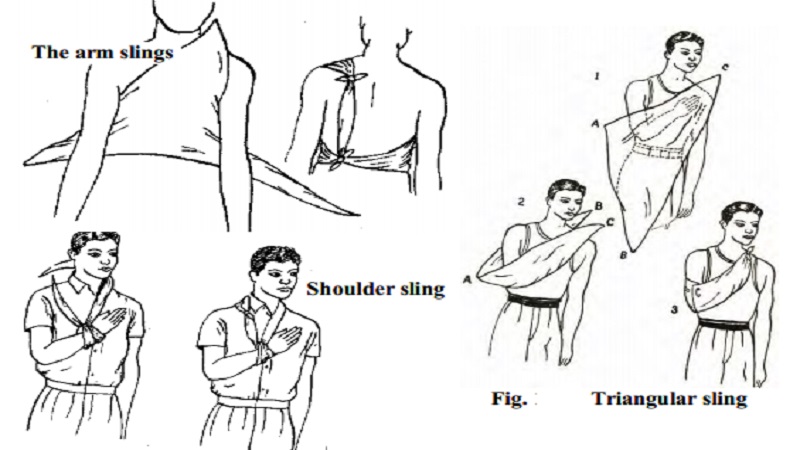Chapter: 11th 12th std standard Class Nursing Health Care Hospital Hygiene Higher secondary school College Notes
Uses, Guidelines and Types of slings

SLINGS
Use of slings
To support injured arms.
To
prevent pull by upper limb of injuries to chest,
shoulder and the neck.
Types of
slings: The arm slings
The
arm sling is used in cases of fractured ribs, injuries of upper limbs and in
cases of fracture in the fore arm, wrist and hands after the application of
splints or plaster casts and bandaging.
Applying the sling
Face the casualty, put one end of
the spread triangular bandage over the uninjured shoulder with the point on the
injured side.
Pass the end around the neck and
bring it over the injured shoulder. The other end will, now , be hanging down
over the chest.
Place
the forearm horizontally across the chest and bring the hanging end up. The
forearm is now covered by the bandage.
Tie the two ends in such a way that
the forearm is horizontally or slightly tilted upwards and the knot is placed
in the pit, above the collar bone.
Tuck the part of sling which is
loose at the elbow, behind the elbow and bring the fold to the front and pin it
up to the front the bandage.
Place the free base of the bandage
in such a way that its margin is just at the base of the nail of the little
finger.
The nails
of all the finger should be exposed.
Inspect the nails to see, if there
is any bluish colour. A bluish colour shows that there is a dangerous
tightening of splint or plasters and therefore, free flow of blood is not
possible.
If the casualty is not wearing a
coat, place a soft pad under the neck portion of the sling to prevent rubbing
of the skin in that place.
Collar and cuff sling
This
sling is used to support the wrist only.
The elbow is bent and the forearm is
placed across the chest in such a way that the fingers touch the opposite
shoulder. In this position, the sling is applied
A
clove hitch is passed round the wrist and the ends tied in the hollow above the
collar bone on the injured side.
Triangular sling
A triangular sling is used in treating a fracture of the
collar bone. It helps to keep the hand raised high up, giving relief from pain
due to the fracture.
Place the forearm across the chest
with the fingers pointing towards the opposite shoulder and the palm over the
breast bone.
Place
an open bandage over the chest, with one end over the hand and the point beyond
the elbow.
Tuck the base of the bandage
comfortably, under the forearm and hand.
Fold the lower end, also round the
elbow and take it up and cross the back over the uninjured shoulder and tie it
with the other free hand into the hollow, above the collar bone.
Tuck
the point between forearm and bandage.
Tuck the fold, so formed, backwards
over the lower half of the arm and fix it with a safety pin.
Related Topics